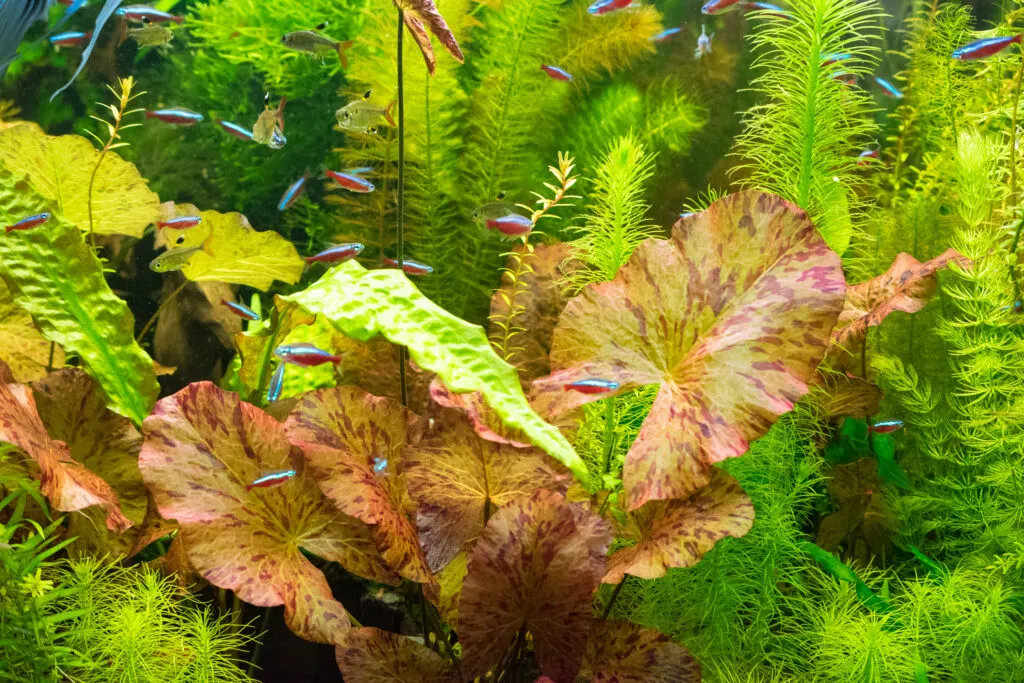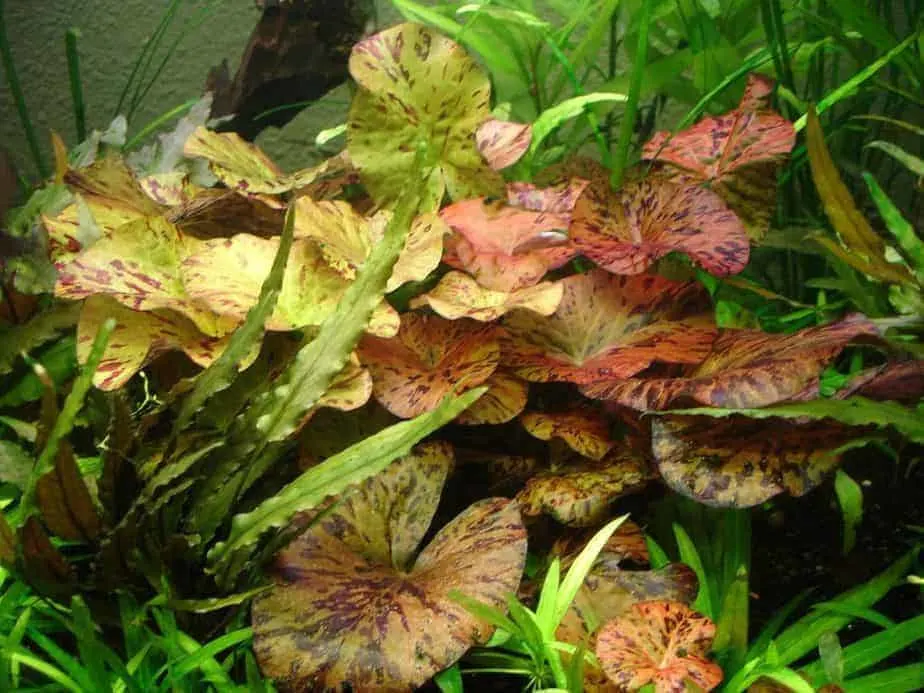If you are just a beginner at this hobby, you might be on the hunt for some hardy plants to add to your aquarium. The red tiger lotus is a beautiful plant that can add many benefits to your ecosystem. Want to know how to properly care for this plant?
Quick Answer
The red tiger lotus is an impressive plant that is perfect for beginners. This hardy species has a high resistance to almost any condition, making it perfect for any aquarist regardless of their expertise. The red tiger lotus received its name due to the distinct red color of its leaves.
Although the red tiger lotus is an easy plant to care for, there are many tips and tricks to learn. Luckily for you, I will explain all of them in this article! Keep reading to discover everything about the red tiger lotus and how to care for it!
What is the red tiger lotus
The red tiger lotus is a freshwater plant that has arrow-shaped red leaves. This plant can thrive in almost any condition. Due to the shape of its leaves, the red tiger lotus is considered a lily pad. The intense red color of this plant can create striking contrast in any freshwater tank.

One of the most remarkable characteristics of this plant is the shape of its leaves. The arrow-shaped leaves can go up to the surface of the aquarium when exposed to intense lighting. This plant can grow from 5 to over 30 inches high.
Regarding its width, the red tiger lotus can surpass 20 inches when given enough room.
As seen in the picture above, the lily pads of the red tiger lotus are rather wide. They can cover a considerable amount of the surface when left alone. This plant also develops strips if exposed to intense lighting.
When the lily pads have reached the surface, they produce white or blue flowers. The blossoms are white by nature, but some variants could have blue or red flowers. These blossoms are one of the propagation ways of this plant.
Here you have some general information about the red tiger lotus:
| Criteria | |
|---|---|
| Common name | Red tiger lotus |
| Latin name | Nymphaea Zenkeri |
| Country of origin | West Africa |
| Difficulty | Easy |
| Lighting requirements | Medium to high |
| Temperature | 22 – 28 degrees Celcius |
| pH | 6.0 – 8.0 |
| GH | Soft to hard |
| KH | 3 – 15 |
| Fertilization needs | Liquid fertilizer |
| Growth speed | Medium |
| CO2 required | Yes |
| Tank placement | Mid – background |
As seen in these conditions, the red tiger lotus is not too demanding, making it perfect for beginners.
Natural habitat
The red tiger lotus grows in the stagnant waters of West Africa. This plant can be found growing in the perimeter of ponds and lakes. In most cases, it appears in shallow waters. The characteristics of its natural habitat have made this plant resistant to many conditions.
The temperature in the waters where this plant grows can vary considerably. For that, this parameter is not particularly harming or benefitting to the growth and health of the red tiger lotus.
Apart from lakes and ponds, any other areas with stagnant waters can host this resilient plant with no problem. The hardy characteristics of the red tiger lotus allow it to grow in many different places without trouble.
Tank Size, Water Parameters, and Lighting Requirements
The red tiger lotus is forgiving regarding most of its requirements. This plant thrives under moderate to intense lighting. Furthermore, the water parameters need not be too strict for the red tiger lotus to do well. Almost any tank size works for the red tiger lotus.
Tank Size
The red tiger lotus is perfect for virtually any tank size. It can grow in nano tanks as well as in bigger tanks. Yet, the recommended minimum size to have all the benefits and beauty of this plant is 10 gallons.
Water parameters
The water parameters can be as ample as you want them to be. The red tiger lotus will not suffer from the water parameter of your aquarium. If your other species can thrive, then so can the red tiger lotus.
Regarding temperature, the red tiger lotus enjoys anything around 22 to 28 degrees Celsius. The pH is also forgiving, so anything that is not too acidic nor too basic will do the trick; aim to 6.0 to 8.0.
Whether the water is soft or hard, the red tiger lotus will thrive. Anything between 2 – 15 GH will be great for the red tiger lotus. The same happens with the KH in your water.
Lighting
The red tiger lotus will not suffer from low lighting in any case. If you have dim lights in your freshwater aquarium, you can still have red tiger lotus growing happily there.
However, this plant prefers medium to intense lighting. With more powerful lights, the red tiger lotus will grow faster and more compact. If you want your lily pads reaching the surface and blossoming white flowers, you might want to crank the lights up a bit.
Remember that many plants in this hobby take their nutrients from lighting, so providing a sufficient amount will improve their growth.
CO2 and Fertilization for the red tiger lotus
The red tiger lotus could do perfectly well without CO2 and fertilization. However, you might want to add these two things to the mix if you are looking for faster growth. In most cases, adding nutrients will result in faster and healthier growth of freshwater plants.
You can add CO2 and liquid fertilizing to the roots of the red tiger lotus to better its conditions in your tank. These nutrients will give a radiant look to the leaves.

Be careful not to oversupply your red tiger lotus since you could end up with a humungous plant without intending it. Also, keep in mind that CO2 and copper can be harmful to some species such as shrimps.
Balancing your lighting, CO2, and fertilizers is paramount for having a sustainable ecosystem in your tank. If you decide to go for any of these added nutrients, be sure to adjust the lighting to keep everything balanced.
Your species will thank you for it!
Propagation and trimming
The red tiger lotus has two different propagation methods: seeds and bulbs. The propagation by seeds is uncommon. Trimming this plant is also paramount to prevent its overgrowth and to keep it in good shape. Controlling the root system is necessary when planting the red tiger lotus.
Propagation
When the lily pads of the red tiger lotus have reached the surface, they produce flowers. Once these flowers have wilted, they spread seeds that could propagate this plant. This way is not so common as propagation by bulbs.
Bulbs are actually the way you plant the red tiger lotus in your tank in the first place. You plant half of the bulb in the substrate and let it do its job. When the plant has reached a considerable size, it starts creating bulbs of its own under the substrate.
These bulbs can create roots and detach from the main plant. That way, a second plant is born from the first red tiger lotus. This propagation could cause the plant to take over the aquarium.
It is crucial to keep the bulbs and the roots controlled to prevent the red tiger lotus from invading unwanted parts of the tank.
Trimming
Besides controlling propagation, trimming is also a good way to keep the red tiger lotus on a leash. You can trim the leaves of the plant that start invading other spaces of the tank.
The leaves of the red tiger lotus will grow and spread to the surface of the tank. If you do not want them to reach those heights, you might want to trim them once you see they start stretching too far.
Some aquarists have started a trend to “train” the red tiger lotus. This means trimming it rapidly when it starts stretching so that the shape of the plant changes. Instead of having long stems and lily pads on the surface, they create bushy red tiger lotus in the bottom of the tank.
With this technique, you can have a completely different plant. The versatility of the red tiger lotus is one of its principal benefits. In some cases, the color of the leaves under the surface can acquire a greenish tone.
You might also want to take this into consideration when deciding if you want a bushy underwater red tiger lotus.
Controlling the roots
The roots of the red tiger lotus can spread farther than you think. For that reason, you might want to keep them under control with a plastic container on the bottom of your tank. The idea is to fill the plastic container with substrate and nutrients to keep the roots contained.
You might want to also use the rocks in your aquarium to keep the container in place and avoid any unwanted movement.
With this information, you will be able to jump into this interesting part of the hobby! Don’t be afraid to start planting some red tiger lotus in your aquarium!
